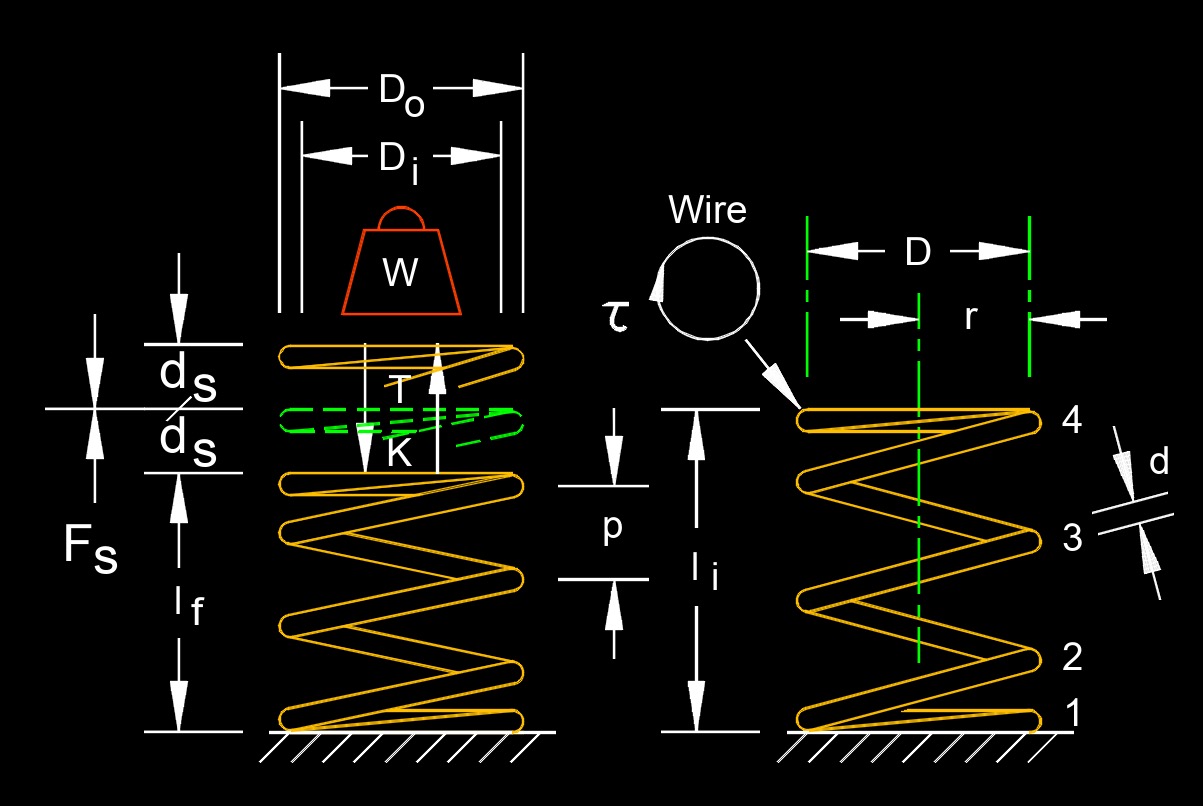Spring Index
Spring Index Formula |
||
|
\( C \;=\; \dfrac{ D }{ d }\) (Spring Index) \( D \;=\; C \cdot d \) \( d \;=\; \dfrac{ D }{ C }\) |
||
| Symbol | English | Metric |
| \( C \) = spring index | \( dimensionless \) | \( dimensionless \) |
| \( D \) = spring diameter | \( in \) | \( mm \) |
| \( d \) = wire diameter | \( in \) | \( mm \) |

Spring index, abbreviated as C, a dimensionless number, is the ratio between the spring and wire diameter for a helical spring. This number tells how tight the springs coils are. All wire sizes have a limit to the coil diameter being formed, too small there can be damage to the material. A higher spring index has a smaller wire and a larger spring diameter. A lower spring index has a larger wire and a smaller spring diameter. The spring index is a critical parameter in spring design because it influences the manufacturing process, the performance, and the durability of the spring.
Spring Index formula |
||
|
\( C \;=\; \dfrac{ 2 \cdot r }{ d }\) (Spring Index) \( r \;=\; \dfrac{ C \cdot d }{ 2 }\) \( d \;=\; \dfrac{ 2 \cdot r }{ C }\) |
||
| Symbol | English | Metric |
| \( C \) = spring index | \( dimensionless \) | \( dimensionless \) |
| \( r \) = spring radius | \( in \) | \( mm \) |
| \( d \) = wire diameter | \( in \) | \( mm \) |
Spring Index Considerations
Manufacturability
Low Spring Index (C < 4) - Springs with a low spring index are difficult to manufacture. The tight coils can lead to problems with coiling and require more precise control during production. These springs are more prone to stress concentrations and can be more difficult to heat treat properly.
High Spring Index (C > 12) - Springs with a high spring index are easier to manufacture but may suffer from instability and buckling under load. They are also more susceptible to bending and may not hold their shape as well.
Performance and Stress Distribution
Optimal Range (C between 4 and 12) - Most spring designs aim for a spring index in this range. This balance ensures ease of manufacture, good performance, and a reasonable distribution of stress within the spring. A moderate spring index helps avoid issues like excessive bending or high stress concentrations, leading to a more durable and reliable spring.
Stress Concentration - A low spring index can lead to high stress concentrations, which can reduce the fatigue life of the spring. Ensuring an optimal spring index helps in evenly distributing the stresses along the spring wire, enhancing its lifespan.
Load and Deflection
Load Capacity - The spring index affects the load carrying capacity of the spring. Springs with a very low or very high index may not perform optimally under load, either failing prematurely or not providing the desired force.
Deflection - Springs with a very high index may exhibit too much deflection for a given load, while springs with a low index may be too stiff.
Buckling and Stability
High Index Springs - Springs with a high spring index are prone to buckling, especially in applications where the spring is subjected to compressive loads. Proper support and guidance can mitigate these issues.
Low Index Springs - These springs are generally more stable but may require more precise manufacturing techniques.
When designing a spring, engineers must consider the application requirements, including space constraints, required load and deflection characteristics, and environmental conditions. The spring index plays a crucial role in balancing these factors to achieve a spring that is both functional and manufacturable. The mechanical spring index is a fundamental parameter in spring design, balancing manufacturability and performance. A spring index typically between 4 and 12 is considered optimal, ensuring that the spring can be manufactured efficiently while providing good performance and longevity. Designers must carefully consider this ratio to avoid issues related to stress concentration, buckling, and overall stability.

